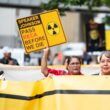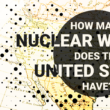Reprocessing in China: A long, risky journey
By |
Since 1983, a closed fuel cycle has been an official element of China's nuclear energy policy. According to proponents, plutonium reprocessing and breeder reactors will allow full utilization of China’s uranium resources, drastically reduce the volume of radioactive waste that must be stored in an underground repository, and establish a way to dispense with the spent fuel accumulating in China’s reactor pools. But Beijing's attempts to develop commercially viable reprocessing facilities and breeder reactors have been afflicted with technological difficulties, serious delays, and cost overruns. At this point—especially taking into account China's ample uranium resources and its easy access to additional resources abroad—it appears very doubtful that reprocessing and fast reactors are the proper way forward for China's nuclear energy sector.
Not according to plan. In 1986, China's State Council approved construction of a pilot civilian reprocessing plant at the Jiuquan nuclear complex in Gansu province. Construction of the plant, designed to produce 50 metric tons of heavy metal a year, started in 1998 and finished in 2005. But the construction process encountered difficulties, delays, and higher-than-expected costs. Finally a hot test was conducted in 2010—24 years after the project's approval. Even then, after only 10 days of operation and the separation of less than 14 kilograms of plutonium, new problems were identified. As of the end of February, 2015, reprocessing had not resumed. Indications are that the plant's annual reprocessing capacity upon resumption could be much lower than the 50 metric tons of heavy metal originally planned.
Separately, the China National Nuclear Corporation (CNNC) has since 2007 been negotiating with France's Areva on the purchase of a commercial reprocessing plant capable of producing 800 tons of heavy metal a year. A series of agreements has been signed, but price remains a sticking point. And Chinese experts are not unanimous about whether China should import a commercial reprocessing plant at all. Some would like to fast-track the deal, while others believe that China should prioritize indigenous technology in order to maintain independence. Indeed, even amid its negotiations with Areva, CNNC began to plan a medium-scale demonstration reprocessing plant, using the pilot plant as a basis. The proposal has not been approved by the government, but in any event the future of the Areva deal is by no means clear.
Parallel with development of the pilot reprocessing plant, China has been working to establish commercially viable plutonium breeder reactors. According to a plan in place until 2013, development of breeder reactors was to be a three-stage process. The first stage was to complete a project known as the China Experimental Fast Reactor. The second stage would involve building, by about 2020, a few demonstration fast reactors. Finally, commercialized fast reactors would be deployed around 2030. Progress always ran far behind schedule.
The China Experimental Fast Reactor is a sodium-cooled experimental fast reactor using technology developed for Russia’s BN-600 reactor. The project, with a planned capacity of 20 megawatts, was approved in 1995. Construction began in 2000. As with the pilot reprocessing plant, the experimental fast reactor encountered many difficulties during construction. Capital cost estimates had to adjusted twice, with each estimate double the previous one. The reactor went critical in July 2010 and, by July 2011, 40 percent of its full power was incorporated into the grid. The reactor, however, was online for only 26 hours during the remainder of 2011, and it produced the equivalent of just one full power-hour. Not until December 2014 did the reactor manage to operate at full capacity for 72 hours. So 19 years passed between project approval and operation at full capacity.
As for the second stage of the pre-2013 plan, CNNC in 2009 signed an agreement with Russia’s Rosatom to jointly construct two copies of Russia’s BN-800 fast neutron reactor in China. But Beijing has not officially approved the project. As with the French reprocessing plant, Chinese experts complain that Russia is demanding too high a price. It is not clear when or if the project will go forward. Instead, CNNC in 2013 began focusing on the development of the indigenous 600-megawatt China Fast Reactor (CFR-600). The start of construction is envisioned for 2017, with operations to commence in 2023—but the government has not approved the project yet.
Experts from CNNC have also, since 2013, urged the development of China's first commercial fast reactor—a 1,000-megawatt reactor based on experience gained from the CFR-600. But CNNC expert Gu Zhongmao—an advocate of the closed fuel cycle—said at a recent workshop on nuclear energy in East Asia that “China needs at least another 20 to 30 years of effort before commercialization of fast reactor energy systems, and there are so many uncertainties ahead. It is beyond our ability to draw a clear picture 20 years ahead.”
Why rush? Should China continue pursuing its plans for fast breeder reactors and commercialized reprocessing? Good reasons exist for avoiding this course of action. First, because most of China's power reactors are newly built, Beijing will face little pressure over the next two decades to reduce its spent fuel burden. And spent fuel can be stored safely, at low cost, in dry casks—or disposed of safely in a deep geological repository.
Second, China faces no shortage of uranium resources for the foreseeable future. The nation's identified resources more than tripled between 2003 and 2012, to 265,500 metric tons from 77,000 metric tons. China's potential uranium reserves amount to more than 2 million tons. Beijing in recent times has also secured huge overseas uranium resources—about three times as large as its own identified uranium reserves. More such reserves could easily be added.
In any event, the cost of uranium accounts for only a small percentage of the cost of power that reactors generate. Simply put, the cost of uranium will not increase in the foreseeable future to levels that would justify the cost of reprocessing and breeder reactors. To the extent that China is concerned about potential disruptions in its uranium supply, it could easily and inexpensively establish a “strategic” uranium stockpile.
China should carefully examine the experiences of nations that have launched large reprocessing programs and built demonstration breeder reactors in the expectation that the commercialization of these reactors would follow. Commercialization did not follow in those countries—but huge expenses were incurred for cleaning up reprocessing sites and disposing of separated plutonium. For China, there is no urgent need to go down this risky road.
Plutonium recycling is much more expensive, and much less safe and secure, than operating light water reactors with a once-through fuel cycle. As for nuclear waste, dry cask storage is a safe, flexible, and low-cost option that can postpone for decades the need either to reprocess spent fuel or to dispose of it directly—allowing time for technology to develop. China has no convincing rationale for rushing to build commercial-scale reprocessing facilities or plutonium breeder reactors.














